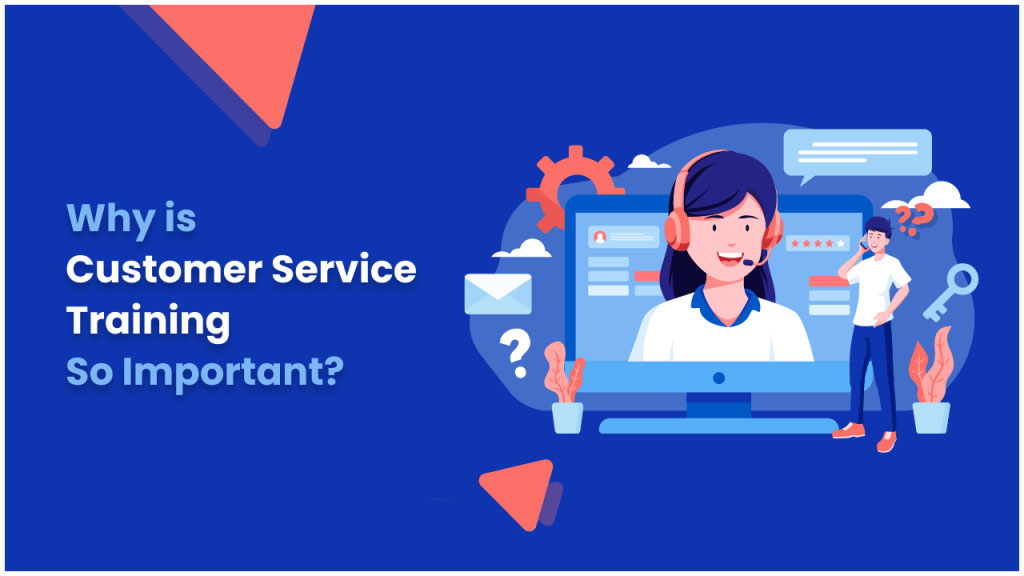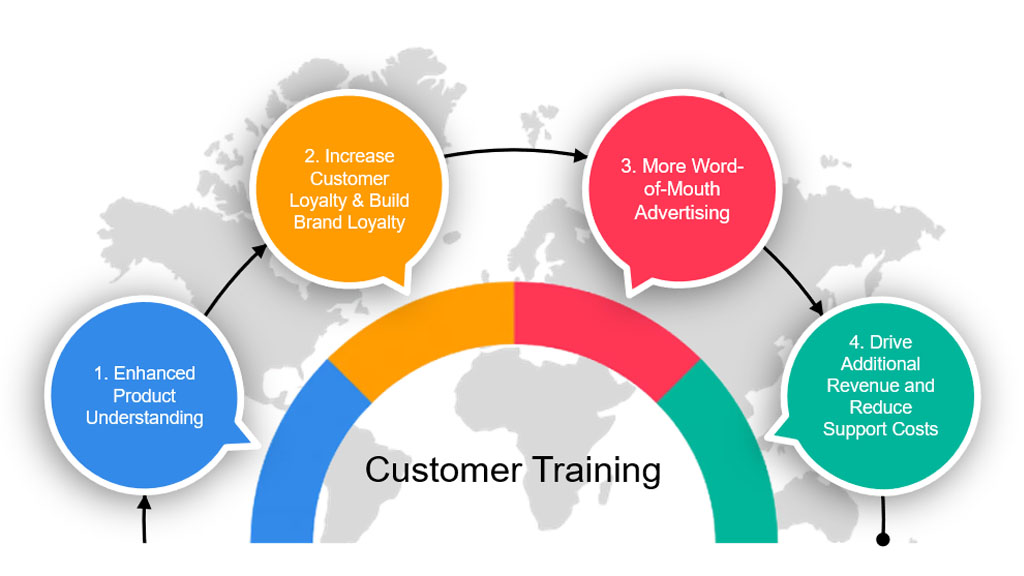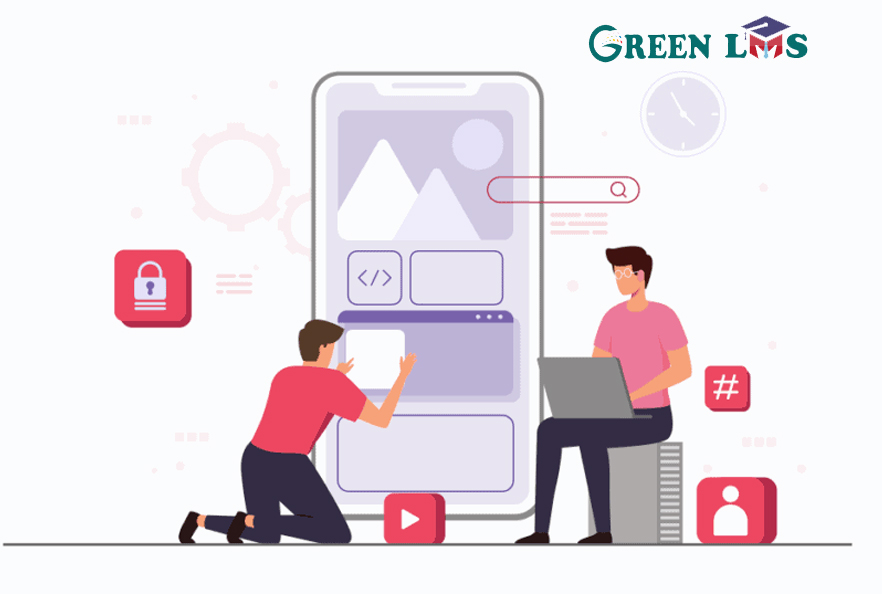In e-learning, the most common target audience is the internal employees of an organization. This makes sense, given the immediate impact your employees will have on your organization’s bottom line. Designing your learning initiatives for the entire company as opposed to just internal audiences has advantages, though. One of those activities, which produce great benefits, is customer training.
Let’s dive deeper into the concept of customer training and explore how to create an external learning program for your organization.
- What is customer training?
- Examples of customer training.
- Why is customer training important?
- Benefits of customer training
- How to create a custom training program
- Enable customer empowerment with your LMS

What is customer training?
The process of educating customers on how to use your products or services to accomplish their goals is known as customer education and is a part of expanded business enablement. In practice, it’s about providing the customer with the educational materials and information they need to be successful and satisfy their organization’s business objections.
The Goal of Customer Training is Threefold:
- Attract and retain customers at each stage of their life cycle
- Improve the customer experience by delivering training that drives value
- Maximize the impact of your product or service within your customer organizations
Customer education can mean different things to different companies, so it’s not a one-size-fits-all approach.
Customer Training Examples: Onboarding, Support, and More
As mentioned, client education comes in many different forms. Learning materials can be guided, personalized, or a combination of both, depending on what your customer base responds best to.
Typically, customer-training programs include one or more of the following elements:
- Guided insertion
- Self-directed learning
- On-demand educational material
- Knowledge bases
- Training and certification programs
Ideally, your customer education program should contain a mix of these content offerings. This will allow your clients to choose where and when they want to consume your training material.
Why is Customer Training Important?
According to Brandon Hall Group’s Extended Enterprise Learning 2020 Research Report, more than half of organizations offer training to external groups other than employees. This includes a mix of customers, channel partners, distributors, value-added resellers, and franchisees.
Of those surveyed for the report, 45% said they actively provide customer training, and 49% agreed that customer training improves customer relationships.
This is the good news. The best news? You don’t need a lot of additional budgets to get these benefits.
On average, according to the report, these activities consume just 10% of most companies’ L&D budgets but present great opportunities for the organization to:
- Create brand awareness
- Improve customer relationships
- Generate additional and recurring income
- Improve the overall customer experience
“Organizations that don’t consider all of their potential learning opportunities could be missing out on critical opportunities to improve customer relationships, increase sales, and generate revenue,” the report said.
One caveat to this is that customer education may not be relevant to all industries or product and service offerings.
Companies that offer software, technology, and subscription services, for example, are well suited to customer education. These businesses must demonstrate their business impact, provide value at every stage of the customer lifecycle, and make sure to communicate that value well in advance of any renewal or upsell opportunities.
Green LMS is a perfect fit. Experience the best of next-gen learning with a free trial of this cloud-based LMS. Discover more about LMS for Business, LMS for Universities, LMS for Schools, LMS for Business, and LMS for Corporate. Secure your Free LMS Trial of this Cloud-based solution today.

Benefits of customer training
A strong customer education program has many important benefits for your company and the customer experience.
Some benefits of customer training for your organization include:
Increase revenue and decrease costs
Great customer training can help increase revenue both directly and indirectly. According to estimates, acquiring a new customer costs five to twenty-five times more than keeping an existing one.
When properly implemented, the benefits of customer education can boost customer loyalty and improve the overall customer experience. As happy customers are more likely to renew their contracts or use your services again, this translates into higher revenue.
Similarly, you can also package and sell training to your clients, which can open up new revenue streams.
Increase engagement with your product or service
People tend to use and value a product or service more if they understand how it works and the value of their work. Customer education programs can be used to quickly grow your customer base so that all users are fully aware of the benefits and impact of your business.
As users become more familiar with your product, through either training or use in the workplace, they are more likely to become fans and potentially advocates of your product or service internally. This helps drive adoption and makes your business a necessity rather than a pleasure.
Strengthen customer retention and create additional sales opportunities
Any salesperson or account manager will tell you that when it’s time to ask for renewal or upsell, you better be able to demonstrate the value your product or service has provided to the customer. If you can’t, your client is unlikely to shell out any more money on a renewal, let alone an upsell or cross-sell.
By providing training and enablement from the front lines, customer education makes sure that the customer is empowered to make the biggest impact on their organization with the product or service. Once you demonstrate that impact, your sales team will have a much easier time explaining why an extension is a good idea or why the customer could benefit from additional products.
Creating brand advocates and champions
The more customers who can demonstrate the impact of your products or services, the more likely they are to become brand advocates and advocates for your company, both internally and to the general public. Once customers become advocates, they become one of your most valuable sales and marketing assets, making them great contacts for case studies, event speakers, and sales referrals.
Reduced customer service costs
Without a customer education program, your support staff or account will have to deal with any questions that arise during the pre-sale, onboarding, and ongoing use of your product or service. Scalability can cause the volume of calls, tickets, chats, and emails to soar and become incredibly resource-intensive.
Customer training lessens this burden by enabling you to address frequently asked questions and problems in a single handy location. Customers can find answers on their own instead of reaching out to your team every time they have a question.
Of course, customer education shouldn’t just benefit your business. The goal is to offer programs that benefit your customers, which in turn have a positive impact on your business. Therefore, it is important to understand why your customers might want customer education and what they will gain from these initiatives.
Some benefits of customer training for your customers include the following:
Provide more effective and efficient customer onboarding
Upgrading with a new product or service can be time-consuming and challenging. Customers expect their onboarding experience to be as seamless as possible, allowing them to start making an impact in their organization as quickly as possible.
Because well-designed customer onboarding programs are quick and scalable, the advantages listed above can be offered for all new contracts.
Establish value and ROI from the start
Customers will have taken a risk to obtain financing for your product or service. They have proposed to their superiors and possibly to senior management, and they will have to keep their promises.
Customer education helps your customers grow quickly and demonstrate the value of your new programs as quickly as possible. This works wonders for customer satisfaction and can help you build staying power within your organization.
Now that we’ve established the benefits of customer training, let’s talk about how to implement your strategy.
How to create a custom training program
Creating an impactful customer training program starts with understanding the needs of your customers. Your goal should be to gain a 360-degree understanding of how your customers are currently learning about your product or information, how they ask questions and receive support, and what type of content they respond to best.
From there, you can create a custom training program that delivers maximum impact where and when your customers need it most.
Here are some key steps to consider achieving this:
1. Find customer support touch points.
The first step is to outline where the important touch points for customer training will be. To help, meet with your sales, account management, customer success, and support teams to determine where and when they typically interact with customers.
Onboarding, technical support, user support, strategic support, and account support are a few examples of key touch points.
2. Understand your customers’ needs at every touch point
Once these touch points are established, work with internal stakeholders to map out all the key business challenges and reporting requirements for each of the phases listed above.
You may also consider turning this activity into a two-way conversation with your customers. Ask them what information and training they might find useful. Create open forums where they can ask questions. Analyze your web traffic, product usage statistics, and internal search queries to see what kind of information people are looking for.
All of this data will offer valuable insight into what customer training material to create and how it should be delivered.
3. Use the right LMS and content
Once you have a clear understanding of the questions your customers are asking, you can start thinking about the best media and delivery platform to use for each type of information.
For example, embedding a video series online through an LMS might be more suitable. Ongoing support might be better suited for a forum or knowledge base. To determine which platforms and media types receive the most engagement, think about creating numerous iterations of the same training and test materials.
4. Improve the customer experience with blended learning
No matter which platforms and resources you choose, your customer-training program should offer blended learning. People learn and process information in many different ways. Some like to learn at their own pace, while others do better in more formal learning settings. Your customer-training program should aim to accommodate these different learning styles.
Be sure to offer a mix of hands-on, live, and self-directed learning. Live webinars and breakout sessions can be used for more formal learning, while video series, presentations, and on-demand quizzes can be used for self-paced learning.
Experiment with a mix of on-demand learning, self-learning, and micro learning to discover what works best for your customer base.
5. Set and Monitor the Right Customer Enablement KPIs
No customer training strategy is complete without a clear set of success metrics. These should be established during the planning phase of the customer-training program and serve as a guide for all new learning initiatives.
Choose one to three KPIs that you will use to track the impact of your customer education program. Time to value, participation in training, customer retention, and the number of requests for direct support, customer satisfaction, renewal rate, and repeat customer spending are a few examples.
Make sure you can evaluate and communicate the ongoing effects of your clients’ learning programs by using learning analytics tools. Track the movement of these KPIs over time to determine whether your customer education program is having a significant impact.
As you begin to put together your customer training strategy, you’ll quickly realize that selecting the right platform is critical to success. We’re biased, but we believe that a high-powered LMS or learning suite is the way to go for any customer training program.
Enable customer training with your learning management system
Just as we educate our employees with the most relevant and exciting content, your customers will also respond to the same materials. It only makes sense to extend the same privileges of a learning platform to its customer base and engage them with quality learning programs.
Echoing that, the aforementioned Brandon Hall Group survey found that 62% of organizations use a learning management system (LMS) for extended enterprise learning, and it’s easy to see why.
An LMS can help drastically improve the customer experience by achieving the following:
Centralize training materials for customers
An LMS is a central location where your customers can find your training materials. Therefore, an LMS allows clients to easily access courses, experts, and other learning resources.
Deliver educational content to customers efficiently
Using an LMS makes it simple to distribute up-to-date e-learning materials to various learners. You can now easily and quickly communicate updates to products and services (such as new features and improved user interfaces) thanks to this.
Enable formal and informal e-learning
As a best practice, client training should support real-time learning and make use of both formal and informal learning methods. A top-tier LMS should have features that support social learning so that customers can learn through social channels.
Measure the success of your customer-training program
One of the biggest benefits of learning technology may be that it provides metrics on student activity. This makes it possible for businesses to collect information that can help them improve their learning initiatives and guarantee the success of their customers.
Connect to your tech stack
Some modern learning suites come with built-in integrations that allow you to access your CRM data. This is invaluable to your sales teams and accounts when it comes time to discuss renewals and upgrades with your clients. Your team can review what training has been completed and what else can be done to improve the impact of your product or service within the client’s business.
As you can imagine, choosing the right LMS is incredibly important. Selecting the right (or wrong) one plays a key role in the success or failure of a client’s training program.
Again, we’re biased, but we like to think of Green LMS as a pro in all of the key considerations listed above.


